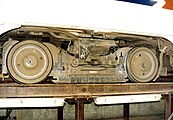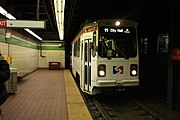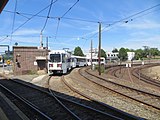SEPTA K-car
This article, SEPTA K-car, has recently been created via the Articles for creation process. Please check to see if the reviewer has accidentally left this template after accepting the draft and take appropriate action as necessary.
Reviewer tools: Inform author |
| SEPTA LRV Series 9000 SEPTA LRV Series 100 | |
|---|---|
 SEPTA 9001, a Series 9000 car, 2006 | |
 SEPTA 124, a Series 100 car, 2007 | |
| In service | November 1980[1]–present |
| Manufacturer | Kawasaki Heavy Industries |
| Replaced | PCC streetcars, Brilliner |
| Constructed | 1980–1981 |
| Number built | Series 9000: 112 cars Series 100: 29 cars |
| Formation | Series 9000: uni-directional vehicle Series 100: bi-directional vehicle |
| Fleet numbers | Series 9000: 9000-9111 Series 100: 100-128 |
| Capacity | Series 9000: 77 people (51 seated) Series 100: 67 people (50 seated) |
| Operators | SEPTA[Note 1] |
| Lines served | Series 9000: SEPTA subway–surface trolley lines Series 100: SEPTA Routes 101 and 102 |
| Specifications | |
| Car length | Series 9000: 15.240 m (50.00 ft) Series 100: 16.16 metres (53.0 ft) |
| Width | Series 9000: 2.592 m (8.50 ft) Series 100: 2.692 m (8.83 ft) |
| Height | Series 9000 and 100: 36 m (118 ft) |
| Floor height | 914 millimetres (2.999 ft) |
| Maximum speed | Series 9000: 80 km/h (50 mph) Series 100: 100 km/h (62 mph) |
| Weight | Series 9000: 26 tons Series 100: 27 tons |
| Acceleration | 4.8 km/(h⋅s) (3.0 mph/s) |
| Deceleration | Series 9000: 6.4 km/(h⋅s) (4.0 mph/s) Series 100: 5.6 km/(h⋅s) (3.5 mph/s) |
| Electric system(s) | Overhead line, 600 V DC |
| Track gauge | 5 ft 2+1⁄2 in (1,588 mm) |
| Notes/references | |
| Sources[2][3][4][5] | |
K-car is a nickname for two different series of trolley cars used by SEPTA that were built by Kawasaki Heavy Industries. The Series 9000 is a streetcar that has been used on the SEPTA subway–surface trolley lines since 1980. The similar Series 100, which was manufactured at the same time, was also built for SEPTA Routes 101 and 102.[3][6][7] The K-cars were Kawasaki's first railroad cars for the American market.
Background
Since the days of privately-owned streetcars before the establishment of the publicly-owned SEPTA, high-performance PCC streetcars built by J. G. Brill Company were used on Philadelphia's streetcars. A similar vehicle manufactured by the same company, the Brilliner, was also active. In 1975, a decade after SEPTA was established., 60 PCC cars were destroyed by a fire in the garage. SEPTA soon leased streetcars from the Toronto streetcar system. However, since the 1970s, the aging streetcars began to break down, and SEPTA has considered replacing them with modern streetcars. The US Standard Light Rail Vehicle (USSLRV) was considered for possible use on SEPTA, [Note 2] but it was rejected due to the many mechanical difficulties experienced by USSLRVs used on the Boston MBTA's Green Line and on Muni Metro in San Francisco. In 1980, the first Series 9000 car, SEPTA 9000, was built.[8][3][9][10][11]
Übersicht
Structure
The Series 9000 for the subway-surface trolleys and the Series 100 for the suburban system have differences in body structure, bogies, current collectors, etc. However, both types can be operated with one car, though multiple-unit train control is also possible. The design was based on a request from SEPTA, and although the interior layout and driving equipment were based on the PCCs and Brilliners, a number of new technologies were introduced.[2][8]
Body/interior
The car body is made of weathering steel, and the underframe other than the pillow frame and the area near the passenger door are stainless steel to prevent corrosion because snow melting agent is sprayed in winter. It is made of: The width of the car is 2,592 mm (Series 9000) and 2,962 mm (Series 100), which are wider than conventional cars, while the end of the car is narrowed toward the front to accommodate the route conditions with many sharp curves, and the width of the gable surface is 1,722 mm. In the design, strength analysis and strength test by finite element method are used to reduce weight, improve safety, and ease of maintenance.[2][12]
The interior is designed by Yashiro Composites of Japan, and the seats of the Series 9000 are made of fibre-reinforced plastic, while the Series 100 for the suburbs has upholstered seats using rubber cushions. High-density glass wool is used for the floor, sides, and ceiling, and polycarbonate sheets with a thickness of 12.7 mm are used for the window glass to improve soundproofing and heat insulation inside the car. The inside of the car is fully equipped with air conditioning for both heating and cooling, but only the upper part of the window glass can be opened inward in case it becomes unusable.[2][13]
Because it was manufactured before the enactment of the Americans with Disabilities Act of 1990, it has a high floor height of 914 mm and requires steps to get on and off the platform on a low floor. Also, since there is no wheelchair lift in the car, passengers who use wheelchairs need to use the ramp placed at the station when getting on and off.[Note 3] The boarding door uses a pneumatic inner folding door, and is equipped with a re-opening and closing function that automatically opens when a foreign object is caught.[4][5][12]
The speed control in the driver's cab is the same as that of the PCC cars, and a pedal that plays the role of force, braking, and a dead-man device is installed at the foot of the driver's cab. In addition to the speedometer and air compression meter, the cab is equipped with various toggle switches and indicator lights indicating the status of the equipment.[15][16]
Equipment
The bogie uses a hollow shaft, with chevron rubber for the axle spring and an air spring for the pillow spring is used, of which the pressure on the air spring is detected by the load bearing device. The bogie frame has a structure that is easy to twist so that the wheels can follow and run stably even on a track in poor condition. The wheels vary depending on the type, and the Type 9000 for the city system has the same elastic wheels as the PCC car, while the Type 100 for the suburban system for high-speed operation uses integrally rolled wheels. In addition to installing two electric motors in both types, disc brakes and electromagnetic brakes (emergency) are equipped as braking devices.[17][18]
The electric motor is a direct current motor (61 kw, 300 V, 230 A, 2,000 rpm) and is controlled by a two-phase double armature chopper control scheme. When driving, the alternating current is generated by the pedal angle, and the main circuit is continuously and smoothly controlled using a microprocessor. In addition to regenerative braking, electric braking can also be used in case of unusability. In addition, an alternator (AC230 V, 3-phase 40 kVA) is also installed as an auxiliary power supply, and the current through the low-voltage power supply is used to charge lighting and storage batteries, lighting, and information broadcasting.[19]
On the roof, in addition to the current collector and various resistors, an air conditioning unit that keeps the temperature inside the car between 18°C and 24.5°C is installed, and in the summer, cold air is sent to the car through the ceiling duct, while in the winter, the heater of the air conditioning unit and the heater with a floor type fan are heated by heating, and the heat generated from the heater is also used for snow melting in the boarding and alighting steps.[20]
-
Interior of a Series 9000 car
-
Bogie of a Series 9000 car
Differences between Type 9000 and Type 100


The Series 9000 for the city system and the Series 100 for the suburban system have the following differences in the body body and bogie in addition to body dimensions, maximum speed, and weight.[2]
| Series 9000 | Series 100 | |
|---|---|---|
| Driver's cab | Uni-directional | Bi-directional |
| Number of doors | 2 doors on the right side (front and middle) | 2 doors on each sides (front and rear) |
| Current collector | Trolley pole | Pantograph |
| Seating arrangement | Cross | Cross-seating, long seat near the boarding door |
| Coupling | Automatic coupler (with electro-pneumatic coupler) | Automatic coupler (with emergency buffer device and electro-pneumatic coupler) |
| Rear lights | 2 lights | 4 lights |
Operation
The prototype completed in 1980, and enter service that June. However, the drawings on the SEPTA structure gauge and signaling system, which were used as a reference during the design, were outdated. As a result, the trolleys touched the platforms, and there were signal problems. To resolve this, SEPTA responded by modifying the trolley lines' infrastructure to match the vehicles made by Kawasaki Heavy Industries. By 1981, 141 cars (the 112 Series 9000 cars, and the 29 Series 100 cars) had been delivered, including prototypes, and all of them were put into commercial operation in 1982. 車両The final assembly of the vehicle was done by Boeing, which was working on the USSLRV.[Note 4] These achievements laid the groundwork for many orders of Kawasaki's electric trains for the New York City Subway over the years.[21][22]
As of 2018, the 112 Series 9000 cars (numbered 9000-9111) run on the SEPTA subway–surface trolley lines, while the 29 Series 100 cars are used on the suburban Routes 101 and 102.[3][4][5]
With the introduction of the K-cars, all Brilliner cars and most of the PCC cars owned by SEPTA were retired, scrapped, preserved, or transferred to other cities. A few PCC cars remained after that, in the 2000s, some cars were modified into the SEPTA PCC II series, which are now used on SEPTA Route 15.[9][23]
-
Series 9000 entering the underground section of the subwaysurface lines (2007)
-
Two Series 9000, coupled together (2002)
-
Series 9000 cars in Elmwood Depot (2015)
-
A three-car train of Series 100 cars (2014)
-
A Series 100 car wrapped to commemorate the Philadelphia and West Chester Traction Company (2014)
Heritage unit
In March 2024, the first-ever K-car, SEPTA 9000, was repainted in a special heritage livery, recreating the livery that it used when it was first built.[1]
Future
As of 2024, the K-cars are over 40 years old. Hence, SEPTA will modernize its public transit network, including the trolleys, as a long-term plan to be carried out until FY2027. As part of this plan, the K-cars are scheduled to be replaced by low-floor trolleys.[24][25]
See also
- Broad Street Line, another SEPTA line using Kawasaki rolling stock
Notes
- ^ SEPTA Metro after 2024.
- ^ Japan's Tokyu Car Corporation also participated in the manufacture of the car bodies and bogies.
- ^ The first SEPTA streetcars to be equipped with barrier-free facilities in compliance with the Americans with Disabilities Act were the "SEPTA PCC II" cars, which were modified between 2002 and 2004.[14]
- ^ Boeing had a business partnership with Kawasaki Heavy Industries to manufacture helicopters.
Sources
- ^ a b @SEPTA_SOCIAL (2024-03-14). "SEPTA_SOCIAL on X: "SEPTA has painted Kawasaki LRV No. 9000 into its original historic paint scheme. LRV 9000 entered service on the Route 11 in November 1980. We would like to thank Woodland Shops dedication employees for doing a magnificent job on this car!"". X, formerly known as Twitter. Retrieved 13 June 2024.
- ^ a b c d e Ito et al. 1980, p. 54-55.
- ^ a b c d Roger DuPuis II 2017, p. 46.
- ^ a b c Delaware Valley Regional Planning Commision (December 2017). "Modern Trolley Staiton Design Guide SEPTA city Transit Division Routes 10, 11, 13, 15, 34 & 36" (PDF). p. 18.
- ^ a b c "Modern Trolley Station Design Guide SEPTA Suburban Transit Division Routes 101 & 102" (PDF). Delaware Valley Regional Planning Commission. May 2018. p. 14.
- ^ "Southeastern Pennsylvania Transportation Authority". Kawasaki Railcar Manufacturing.
- ^ Ito et al. 1980, p. 53-61.
- ^ a b Ito et al. 1980, p. 53.
- ^ a b Roger DuPuis II 2017, p. 10.
- ^ Chiasson, George (1984). "LRV's in Boston: The Road Back". Rollsign. Boston Street Railway Association: 11–12.
- ^ Ohga 2016, p. 65.
- ^ a b Ito et al. 1980, p. 56.
- ^ "沿革 Milestones". Yashiro Composite.
- ^ "HERITAGE RESTORATIONS". Brookville Equipment Corporation.
- ^ Ito et al. 1980, p. 57.
- ^ Ohga 2016, p. 58.
- ^ Ito et al. 1980, p. 58-60.
- ^ Ohga 2016, p. 55.
- ^ Ito et al. 1980, p. 59-60.
- ^ Ito et al. 1980, p. 60.
- ^ Takeda, Shinobu (17 November 2015). "アジア・米でブランド定着 川重の鉄道 世界を駆ける(1)" [Brand Establishment in Asia and the U.S.: Kawasaki Heavy Industries' Trains Travel the World] (in Japanese). The Nikkei.
- ^ "構造解析、NY地下を攻略 川重の鉄道 世界を駆ける" [Structural Analysis, Conquering the New York Underground: Kawasaki Heavy Industries' Trains Running Around the World] (in Japanese). The Nikkei. 2015-11-18.
- ^ "1062 - Pittsburgh, Pennsylvania". Market Street Railway.
- ^ "Fiscal Year 2016 Capital Budget" (PDF). SEPTA. 2016.
- ^ "Fiscal Year 2019 Capital Budget" (PDF). SEPTA. May 2018. p. 68.
References
- Ohga, Juro (1 March 2016), 路面電車発達史 ―世界を制覇したPCCカーとタトラカー, 戎光祥レイルウェイ・リブレット 1, Ebisu Kosho Publishing, ISBN 978-4-86403-196-7
{{citation}}: CS1 maint: date and year (link)
- Ito, Haruo; Tsukikawa, Yoshio; Fujii, Shuichi; Iwamura, Akira (November 1980). "フィラデルフィア向け高性能路面電車". Vehicle Technology (151). Japan Railway Rolling Stock Manufacturers Association: 53–61. doi:10.11501/3293436. ISSN 0559-7471.
{{cite journal}}: CS1 maint: date and year (link)
- Roger DuPuis II (23 January 2017). Philadelphia Trolleys: From Survival to Revival. Images of Modern America. Arcadia Publishing. ISBN 9781467123884.
{{cite book}}: CS1 maint: date and year (link)








